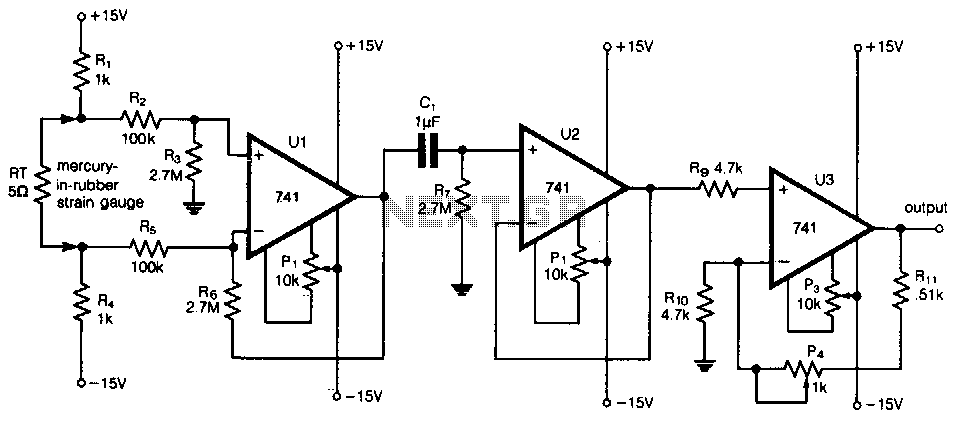
Breath-monitor

The mercury-in-rubber strain gauge serves as a detector for breathing. In this model device, the strain gauge produced by Medimatic, Denmark, is utilized. The length change of the strain gauge, which is wrapped around the chest during breathing, results in a varying electrical resistance of approximately 0.2 ohms/cm. The constant current flowing through resistors R1, R2, and R4 provides a constant component at the output of the U1 differential amplifier. The resistance change of the strain gauge caused by breathing generates a proportional variation in the output voltage of the U1 amplifier. Additionally, the voltage follower based on U2 isolates the output voltage of the filter from the input stage amplifier. U3 functions as a non-inverting amplifier with regulated gain. This device requires a stabilized constant voltage supply of ±15 V.
The circuit design incorporates a mercury-in-rubber strain gauge configured to detect minute changes in chest expansion during respiration. The strain gauge's electrical resistance changes in response to mechanical deformation, producing a measurable signal that correlates with respiratory activity. The U1 differential amplifier amplifies the small voltage variations resulting from the strain gauge's resistance changes, providing a robust output signal for further processing.
Resistors R1, R2, and R4 are strategically placed to ensure that a constant current flows through the strain gauge, enabling the differential amplifier to accurately measure fluctuations in resistance. The output from U1 is a differential signal, which is then fed into a voltage follower circuit using U2. This configuration serves to buffer the signal, preventing loading effects that could distort the output voltage.
Subsequently, U3 acts as a non-inverting amplifier, providing additional gain to the buffered signal while maintaining the integrity of the original signal. The gain of U3 can be adjusted to suit the specific application requirements, allowing for flexibility in signal processing. The entire circuit operates on a dual power supply of ±15 V, ensuring stable operation and consistent performance across varying environmental conditions.
This design is particularly useful in medical applications where precise monitoring of respiratory patterns is crucial. The combination of the strain gauge and the amplifying circuitry allows for accurate detection and analysis of breathing, which can be vital for patient monitoring and diagnosis.The mercury-in-rubber strain gauge is the detector of breathing. In the model device, the strain gauge produced by Medimatic, Demark was used. The change in the length of the strain gauge wrapped around the chest during breathing causes a varying electrical resistance of about 0.2 0/cm. The constant current passing Rl, R rand R4 gives the constant component on the output of Ul differential amplifier.
The change in the resistance of the strain gauge, which results from breathing, produces proportional varying in output voltage of Ul amplifier. The voltage follower, based on U2, separates the output voltage of the filter from the input stage amplifier. U3 works as a noninverter amplifier with regulated gain. This device should be supplied with a stabilized constant voltage of ±15 V. 🔗 External reference
The circuit design incorporates a mercury-in-rubber strain gauge configured to detect minute changes in chest expansion during respiration. The strain gauge's electrical resistance changes in response to mechanical deformation, producing a measurable signal that correlates with respiratory activity. The U1 differential amplifier amplifies the small voltage variations resulting from the strain gauge's resistance changes, providing a robust output signal for further processing.
Resistors R1, R2, and R4 are strategically placed to ensure that a constant current flows through the strain gauge, enabling the differential amplifier to accurately measure fluctuations in resistance. The output from U1 is a differential signal, which is then fed into a voltage follower circuit using U2. This configuration serves to buffer the signal, preventing loading effects that could distort the output voltage.
Subsequently, U3 acts as a non-inverting amplifier, providing additional gain to the buffered signal while maintaining the integrity of the original signal. The gain of U3 can be adjusted to suit the specific application requirements, allowing for flexibility in signal processing. The entire circuit operates on a dual power supply of ±15 V, ensuring stable operation and consistent performance across varying environmental conditions.
This design is particularly useful in medical applications where precise monitoring of respiratory patterns is crucial. The combination of the strain gauge and the amplifying circuitry allows for accurate detection and analysis of breathing, which can be vital for patient monitoring and diagnosis.The mercury-in-rubber strain gauge is the detector of breathing. In the model device, the strain gauge produced by Medimatic, Demark was used. The change in the length of the strain gauge wrapped around the chest during breathing causes a varying electrical resistance of about 0.2 0/cm. The constant current passing Rl, R rand R4 gives the constant component on the output of Ul differential amplifier.
The change in the resistance of the strain gauge, which results from breathing, produces proportional varying in output voltage of Ul amplifier. The voltage follower, based on U2, separates the output voltage of the filter from the input stage amplifier. U3 works as a noninverter amplifier with regulated gain. This device should be supplied with a stabilized constant voltage of ±15 V. 🔗 External reference